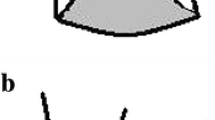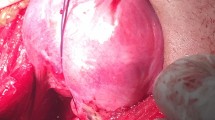Abstract
Introduction.
Complete occlusion of the cervical canal following conization is an uncommon complication.
Case report.
We encountered a case in a woman with lactation amenorrhea who after conization to treat cervical intraepithelial neoplasia (CIN) 3 developed hematometra and did not resume menstruation. This case was diagnosed early by ultrasonic tomography and magnetic resonance imaging (MRI).
Conclusion.
Postpuerperal amenorrheic women should be managed with care because of the increased risk of occlusion of the cervical duct after conization.
Similar content being viewed by others
Explore related subjects
Discover the latest articles, news and stories from top researchers in related subjects.Avoid common mistakes on your manuscript.
Introduction
Stenosis of the cervical duct following conization is not an infrequent complication. Complete occlusion, however, has been reported to be rare, with an incidence of around 1% or less, although the incidence varies with the method of conization [1, 2, 3]. It has been recommended that a temporary stent be placed in the cervical canal to prevent postoperative cervical stenosis [4], but since cervical stenosis tends to occur 2 months or more after surgery [1], and the use of indwelling tubes and the timing of insertion must be reconsidered. We report the case of a woman who was diagnosed as having hematometra secondary to occlusion of the cervical canal. She had been found to have cervical intraepithelial neoplasia (CIN) 3 during pregnancy and had been treated by cervical conization 3 months after delivery, during the period of postpuerperal amenorrhea. Three months postoperatively she complained of menstrual-cramp-like symptoms and persistent amenorrhea.
Case report
A 29-year-old woman was diagnosed with cervical CIN3 at 6 months of pregnancy and was referred to our department. The patient's consent was obtained, and the pregnancy was completed with the Pap smear performed periodically. The Pap smear and histopathological examination of the cervical punch biopsy 5 weeks after delivery showed class IIIb and CIN 3, respectively, and surgical cervical conization was performed 10 weeks after delivery. The operation was carried out with a cold knife, and the wound was left open. Bleeding was arrested with two sutures each of absorbable and silk thread. The excised tissue was 2.8×2.7×1.4 cm (H×W×D) in size, and histological examination revealed squamous metaplasia with negative margins. The two silk thread sutures were removed on day 14 after surgery, when it was confirmed with a sound that the cervical canal was patent.
The amenorrhea persisted after surgery, and 3 months postoperatively the patient complained of experiencing menstrual-cramp-like symptoms for 3 days. Distension of the intrauterine cavity and fluid accumulation were then detected by transvaginal ultrasonography (Fig. 1a), and a diagnosis of hematometra was made by magnetic resonance imaging (MRI) (Fig. 2a). Because the external os of the uterus could not be identified macroscopically, the external os was opened surgically with ultrasonographic monitoring under general anesthesia. A 30-ml volume of slightly viscous, wine-colored fluid was drained from the os, and a tube was inserted into the cervical canal for 10 days to prevent re-adhesion. MRI following removal of the tube showed no evidence of fluid accumulation in the uterus (Fig. 2b), and menstruation resumed 20 days after surgery. No abnormal findings were detected in the uterus by ultrasound imaging (Fig. 1b).
Discussion
The incidence of hematometra secondary to stenosis of the cervical canal following conization with a cold knife has been reported to be around 1% or less, depending on the methods used [1, 2, 3]. In some of the cases reported the patients have resumed normal menstruation after surgery, but later developed constriction of the canal that resulted in amenorrhea [5, 6]. In the present case, the patient was diagnosed as having CIN3 during pregnancy and underwent surgery during the period of postpuerperal amenorrhea. The patient's amenorrhea persisted, and she was found to have an occluded cervical canal 6 months after delivery when she consulted us. The occluded region was less than 3 mm thick, there was no cervical stenosis (Fig. 3) and the external os could not be detected, and thus the occlusion was probably caused by adhesion of scar tissue during the healing process. When the suture threads were removed on postoperative day 14, the patency of the cervical canal was confirmed with a sound, and thus the canal must have occluded afterwards.
Menses usually resume within a month after surgery, and the menstrual blood passing through the cervical duct may help prevent occlusion. If that is the case, it may be beneficial to induce withdrawal bleeding. Because of frequent examinations the occlusion in the present case was found in the early stage of hematometra. In similar cases, however, diagnosis may be delayed because of postpuerperal amenorrhea. Early diagnosis is important in maintaining fertility, and when surgical conization is to be carried out during postpuerperal amenorrhea, the progress of the disease should be carefully monitored with the risk of postoperative occlusion of the cervical canal in mind.
References
Baldauf JJ, Dreyfus M, Ritter J, Meyer P, Philippe E (1996) Risk of cervical stenosis after large loop excision. Obstet Gynecol 88:933–938
Delmore J, Horbelt DV, Kallail KJ (1992) Cervical conization: cold knife and laser excision in residency training. Obstet Gynecol 79:1016–1019
Hagen B, Skjedestad FE, Bratt H, Tingulstad S, Lie AK (1998) CO2 laser conization for cervical intraepithelial neoplasia grade II–III: complication and efficacy. Acta Obstet Gynecol Scand 77:558–563
Leusley DM, Redman CW, Buxton EJ, Lawton FG, Williams DR (1990) Prevention of post-cone biopsy cervical stenosis using a temporary cervical stent. Br J Obstet Gynecol 79:334–337
Pschera H, Kjaeldgaard A (1990) Haematocervix after conization diagnosed by ultrasonography. Gynecol Obstet Invest 9:309–310
Reuter KL, Young SB, Daly B (1994) Hematometra complicating conization with radiologic correlation. A case report. J Reprod Med 39:408–410
Acknowledgement.
This study was supported by the Terry Fox Foundation.
Author information
Authors and Affiliations
Corresponding author
Rights and permissions
About this article
Cite this article
Hirai, K., Kanaoka, Y., Sumi, T. et al. Occlusion of the external cervical os after conization in a postpuerperal amenorrheic woman. Arch Gynecol Obstet 270, 64–66 (2004). https://doi.org/10.1007/s00404-002-0439-8
Received:
Accepted:
Published:
Issue Date:
DOI: https://doi.org/10.1007/s00404-002-0439-8







